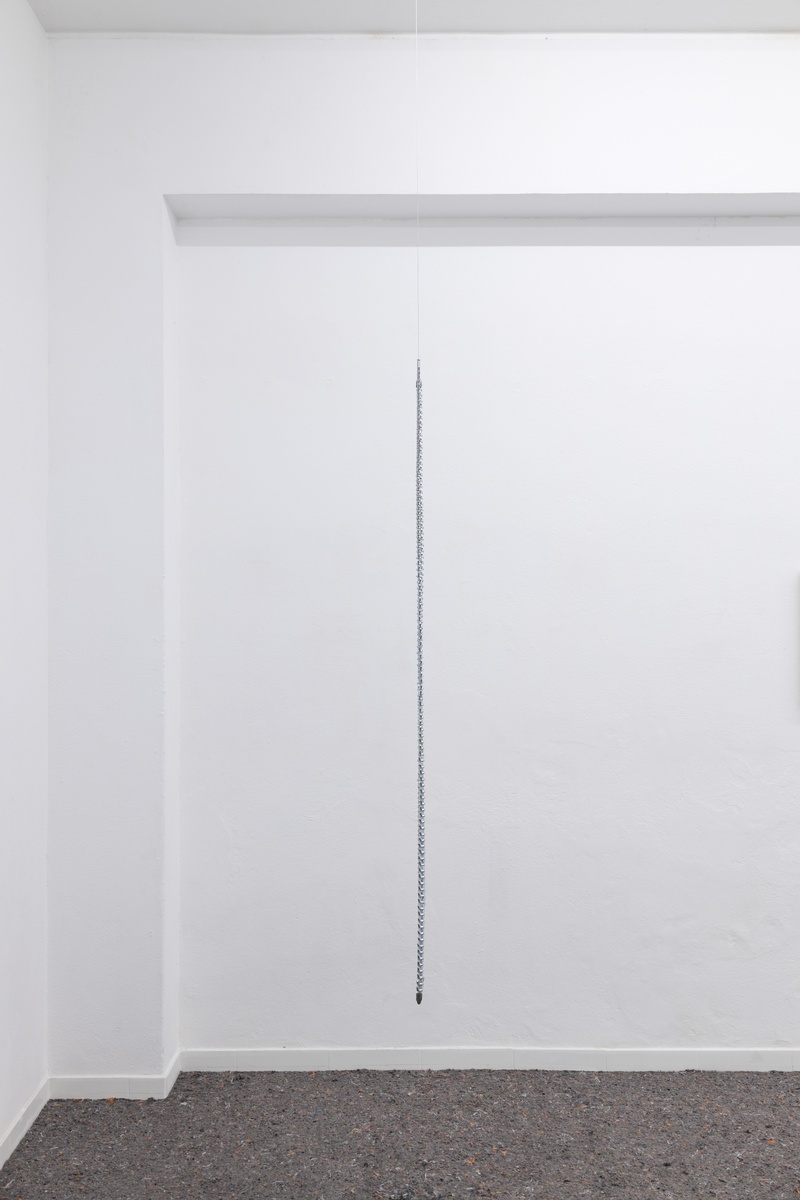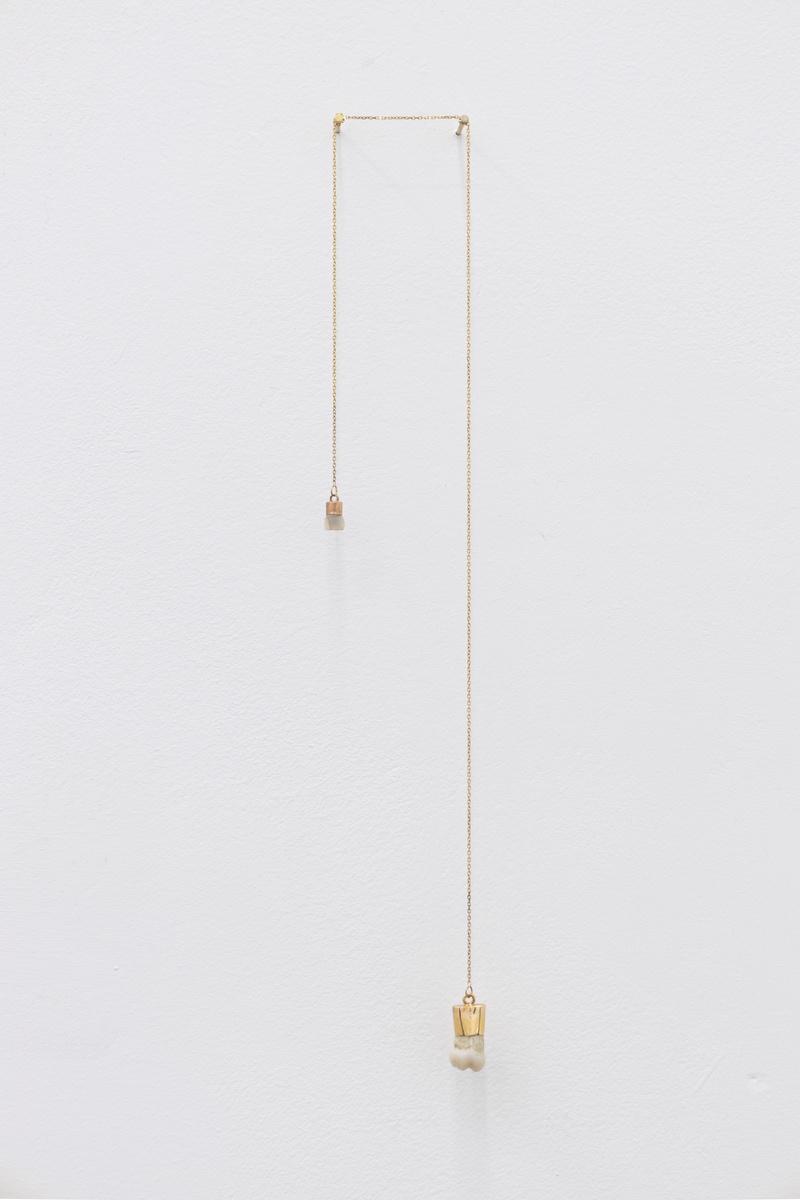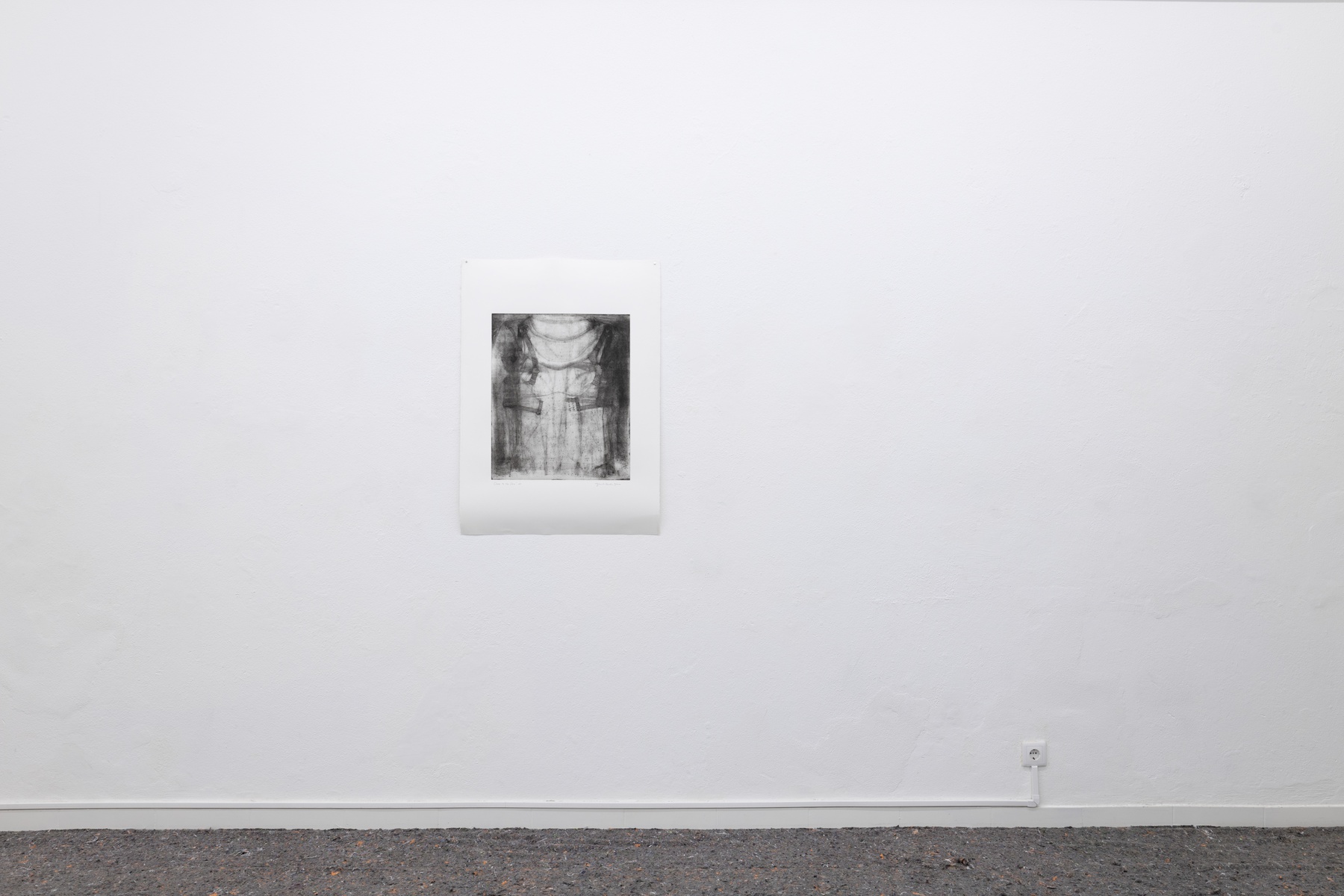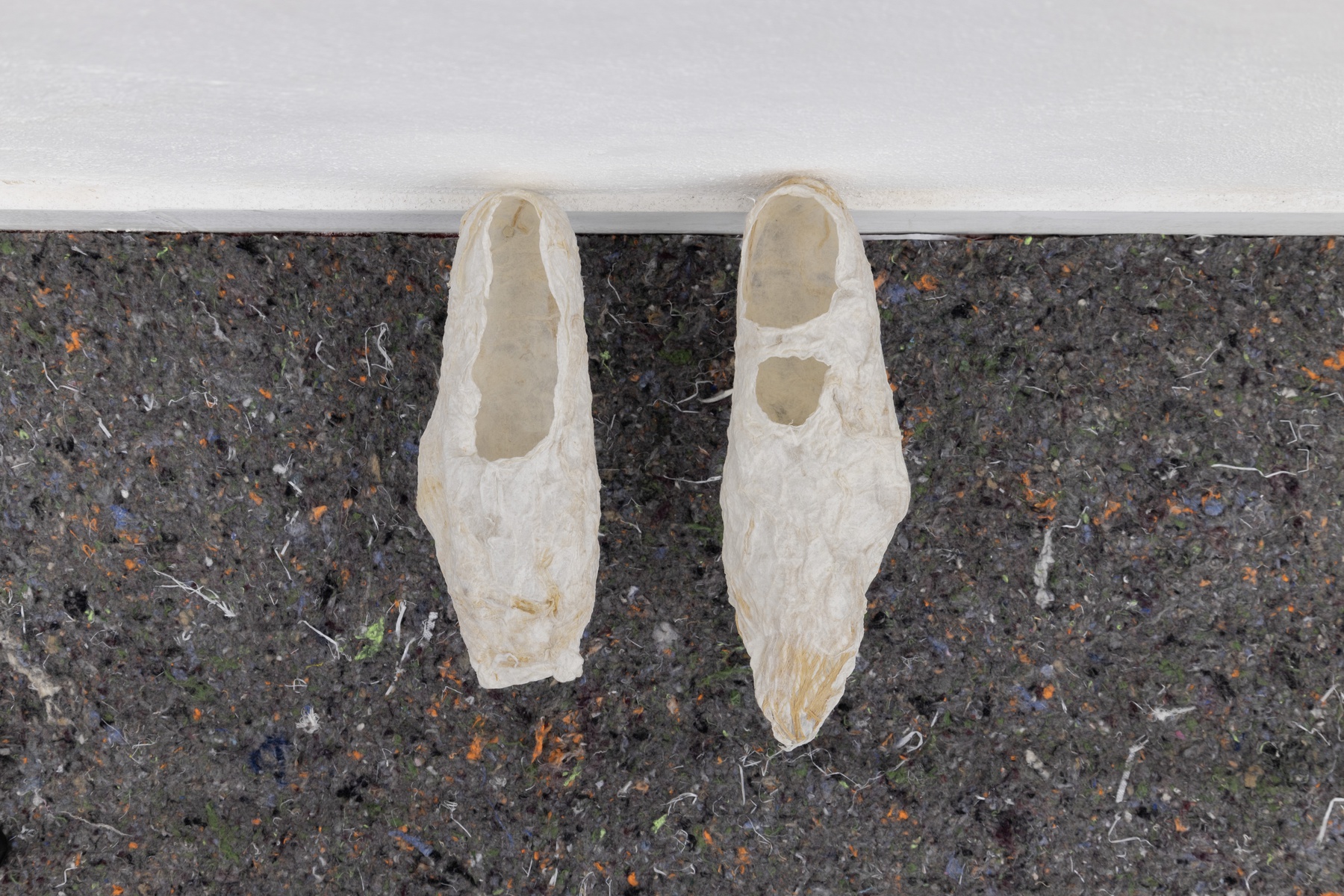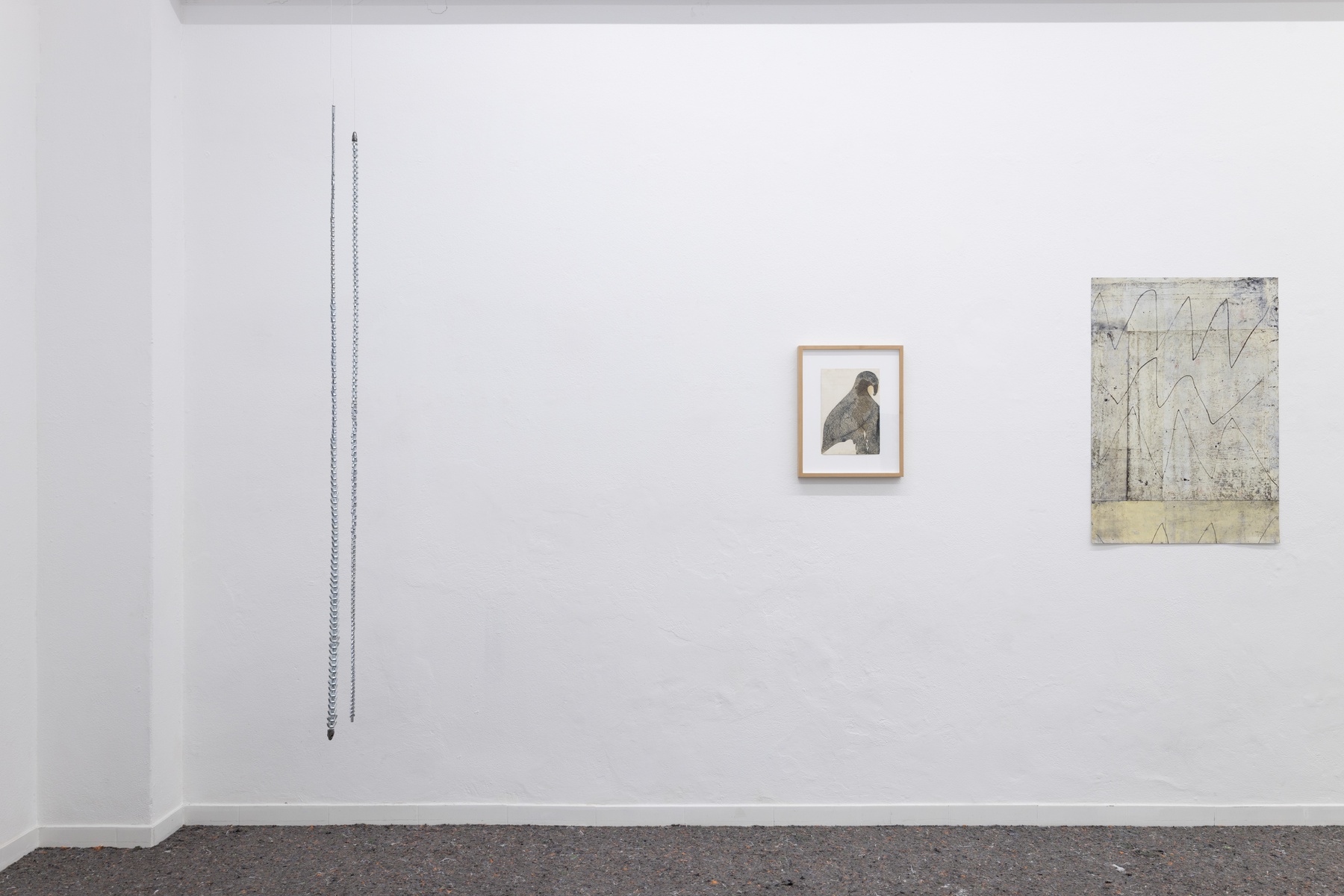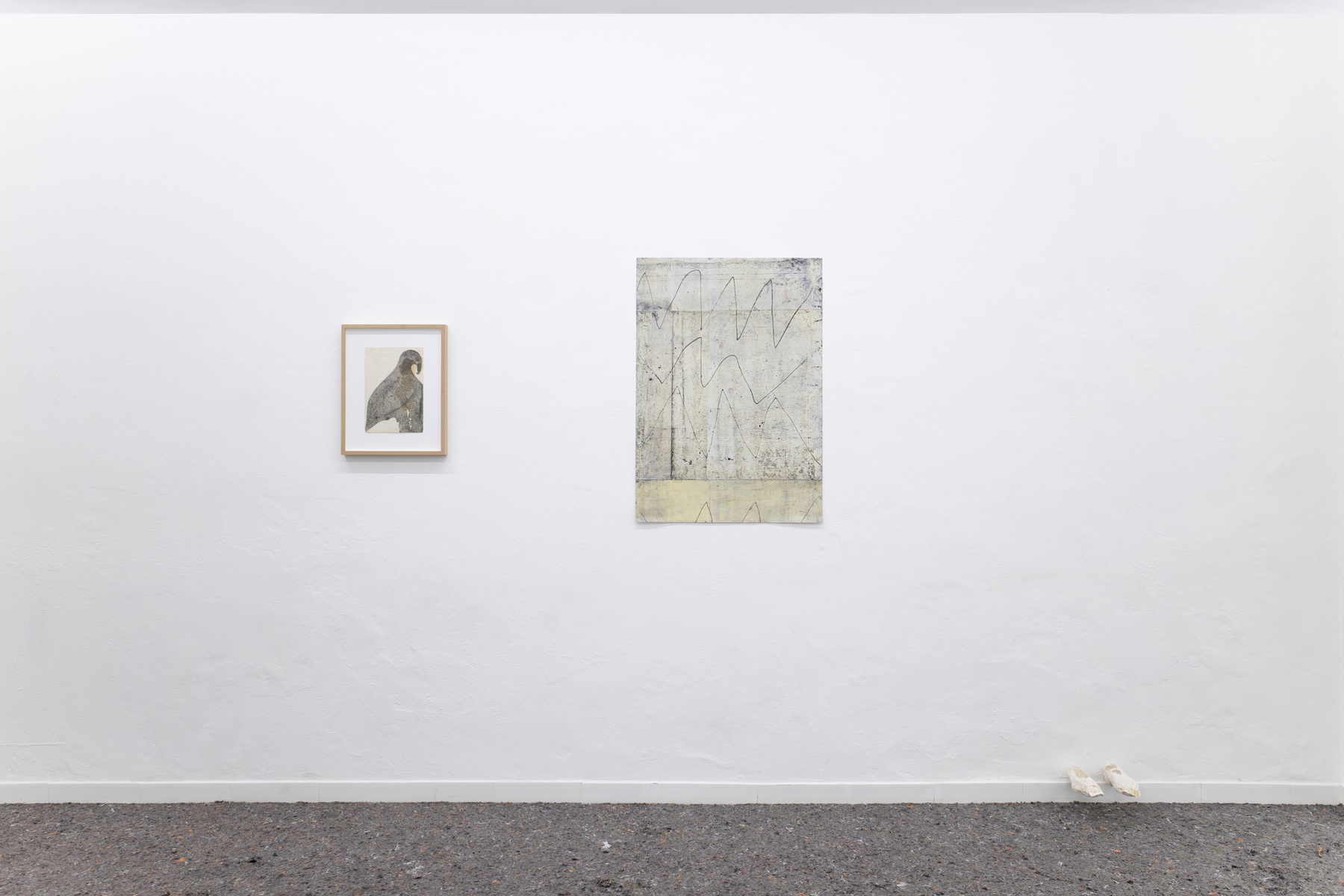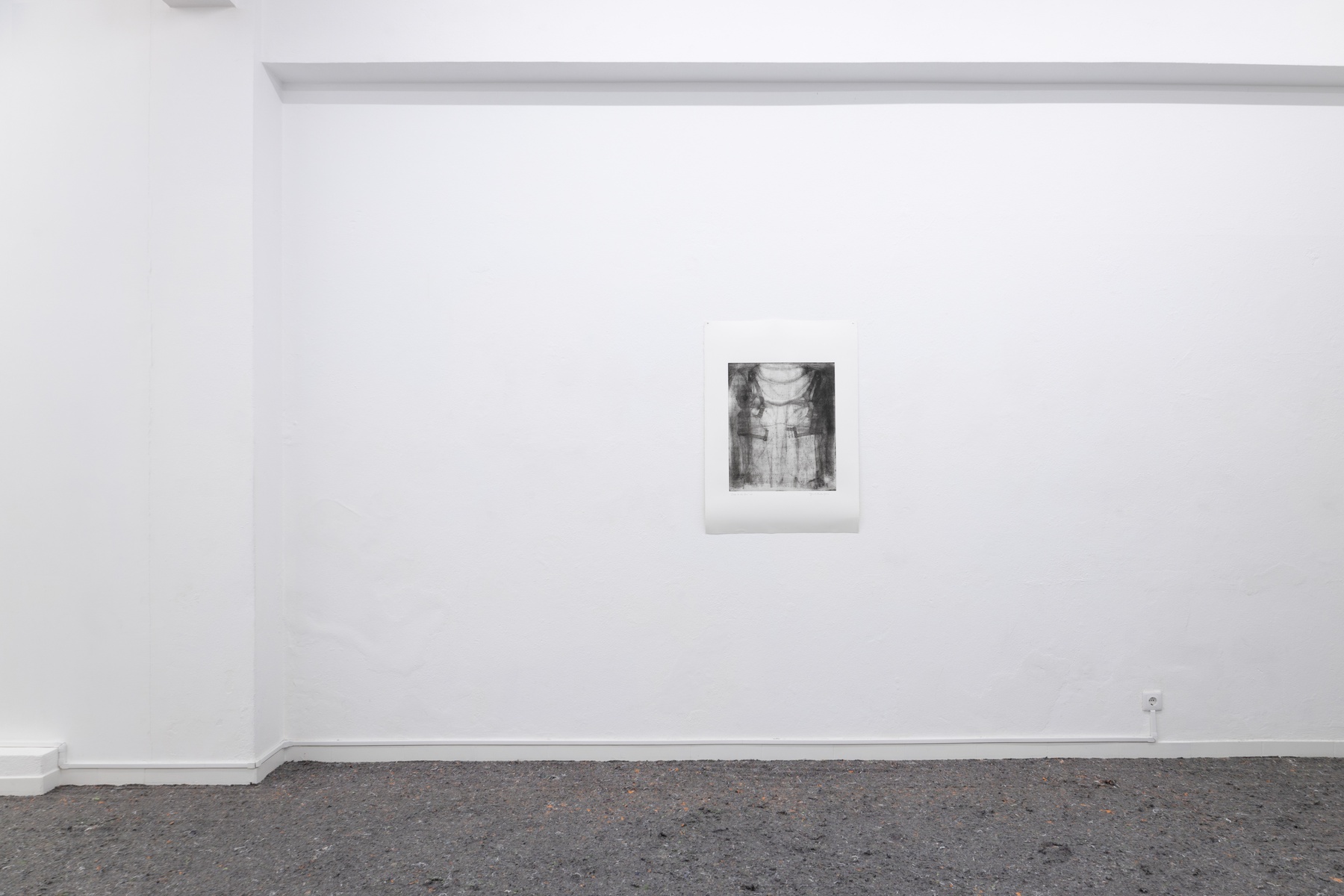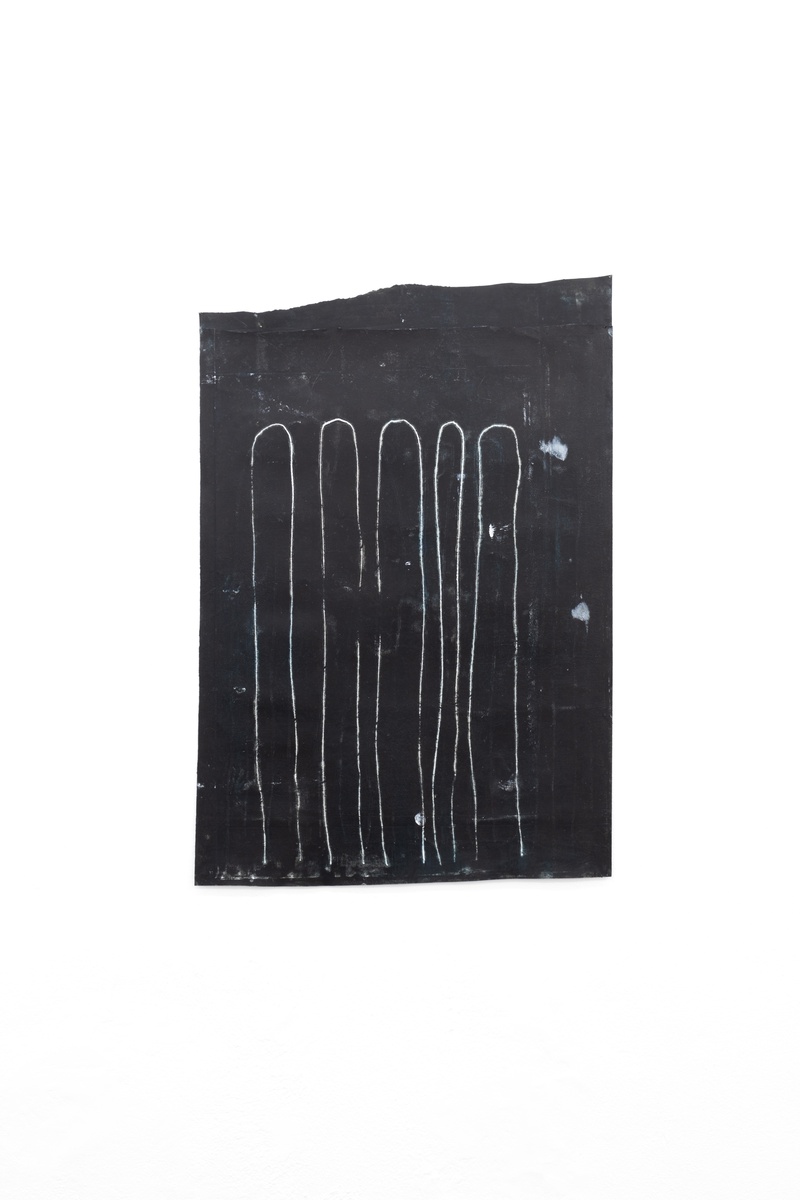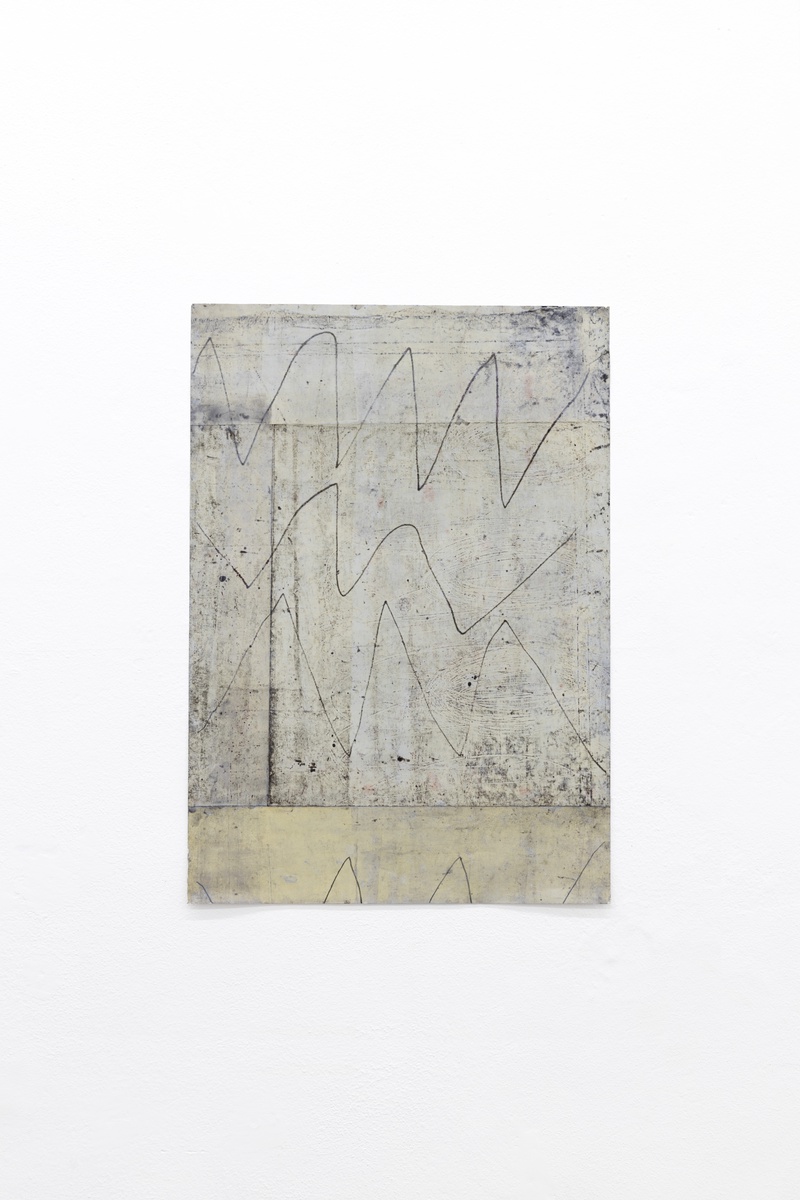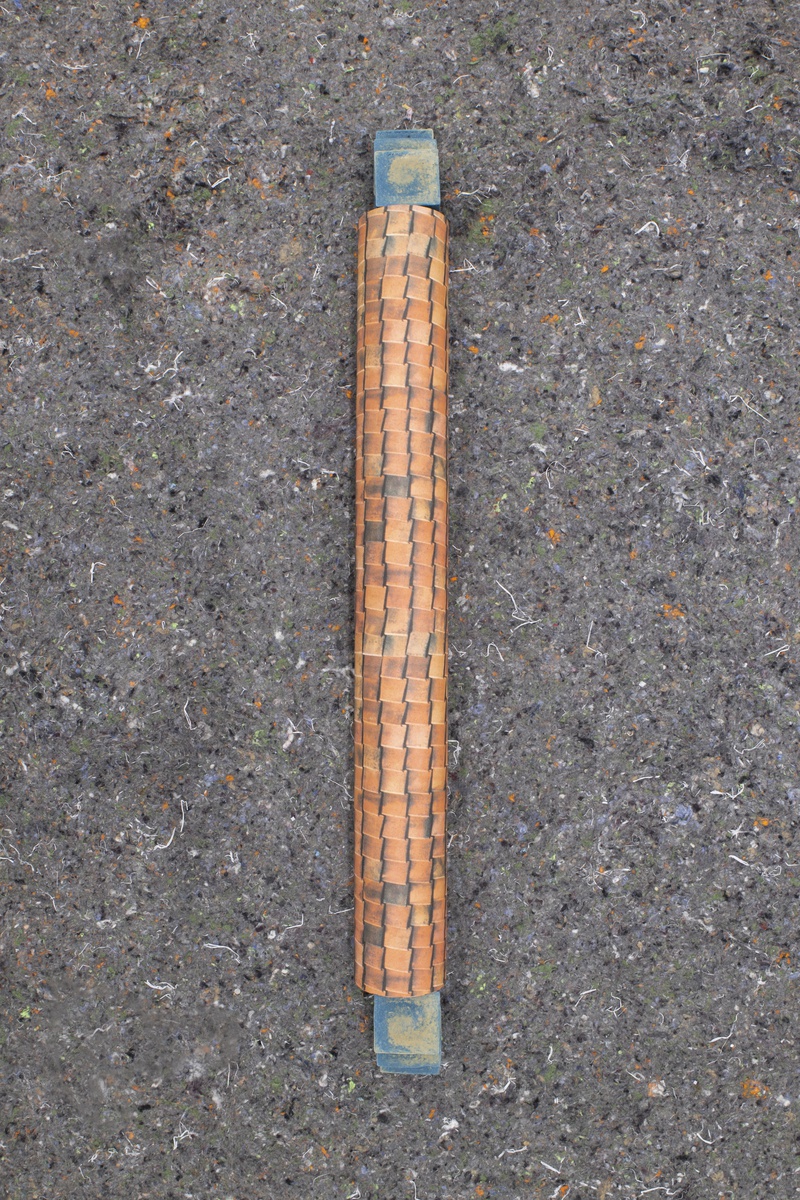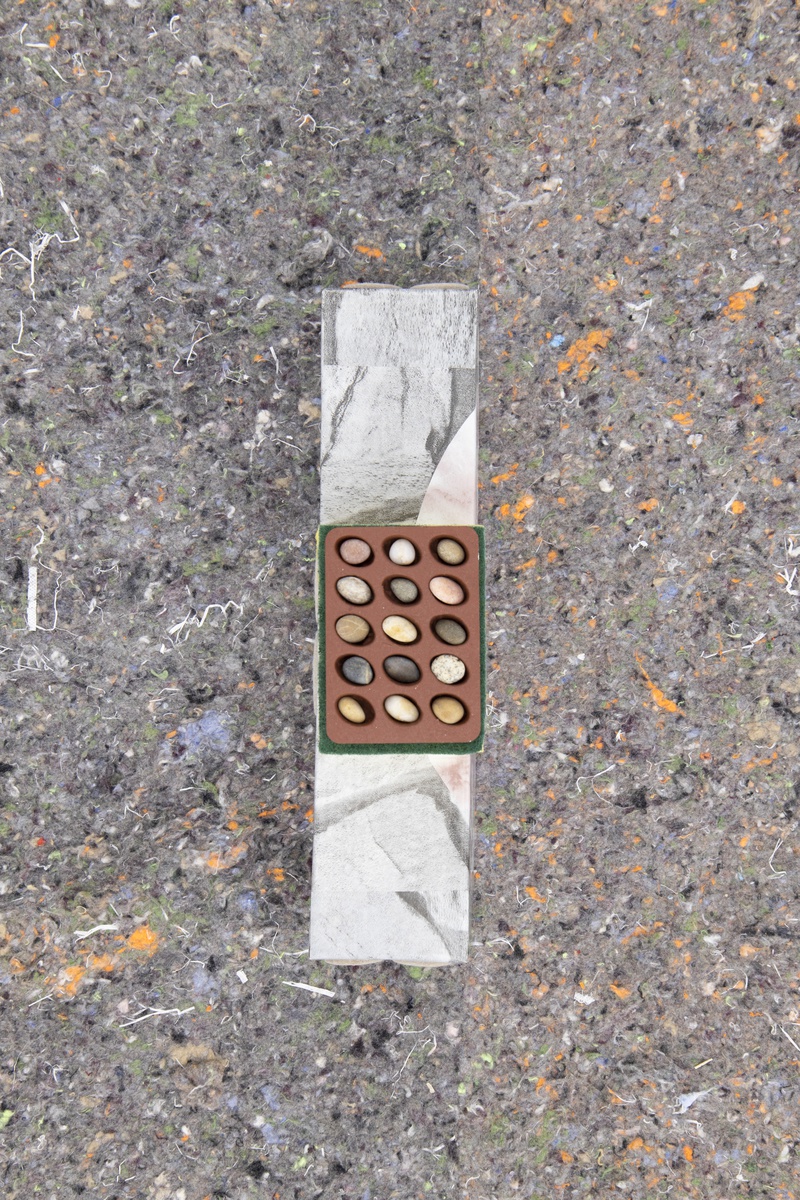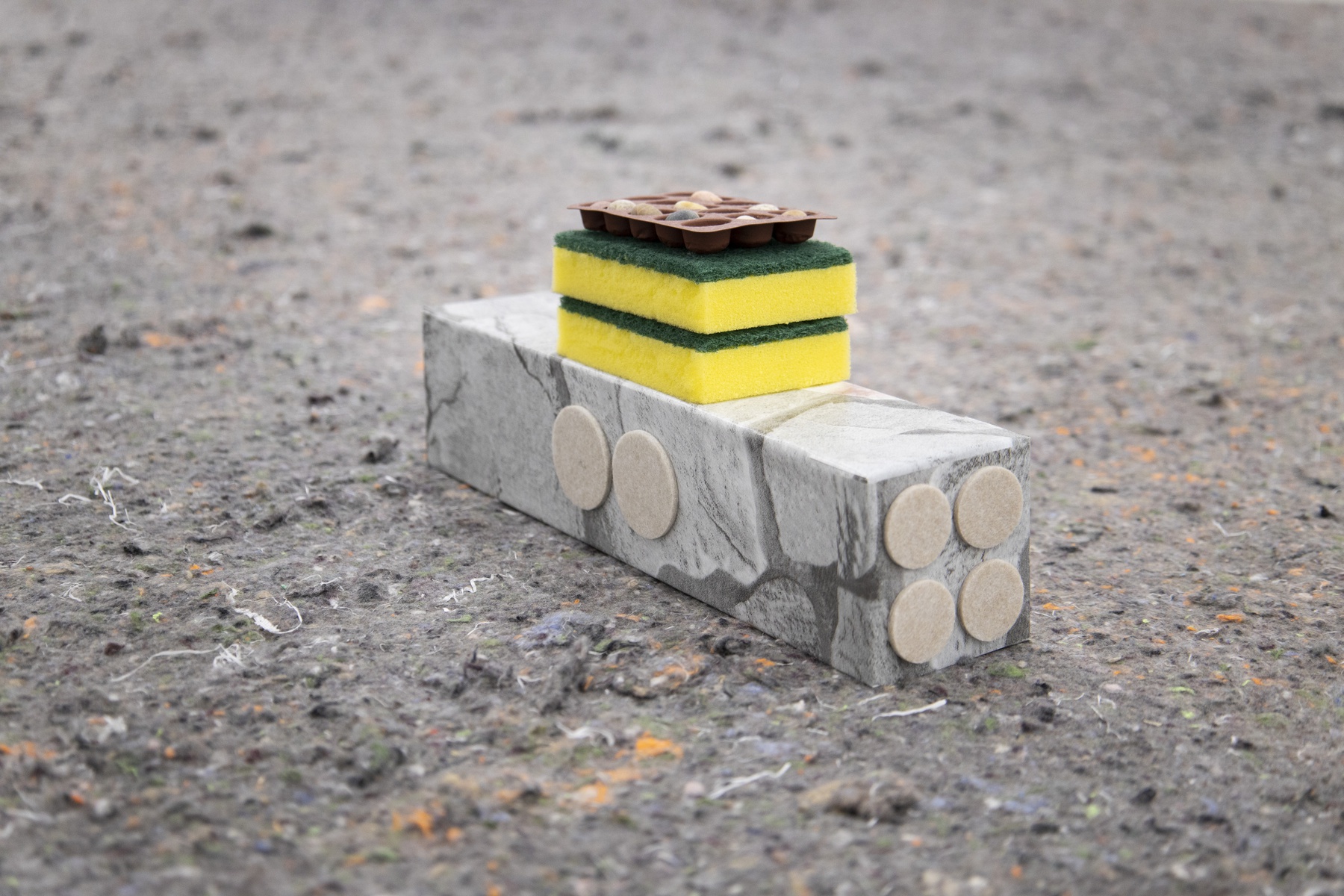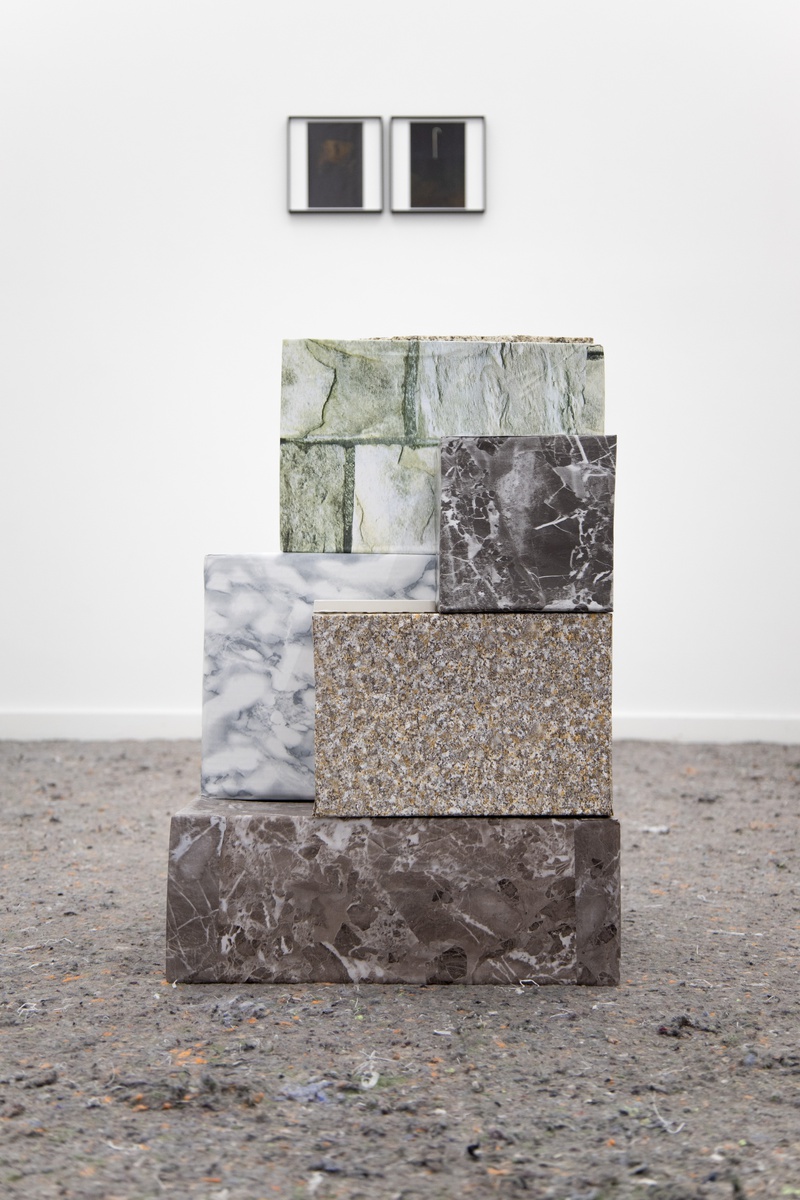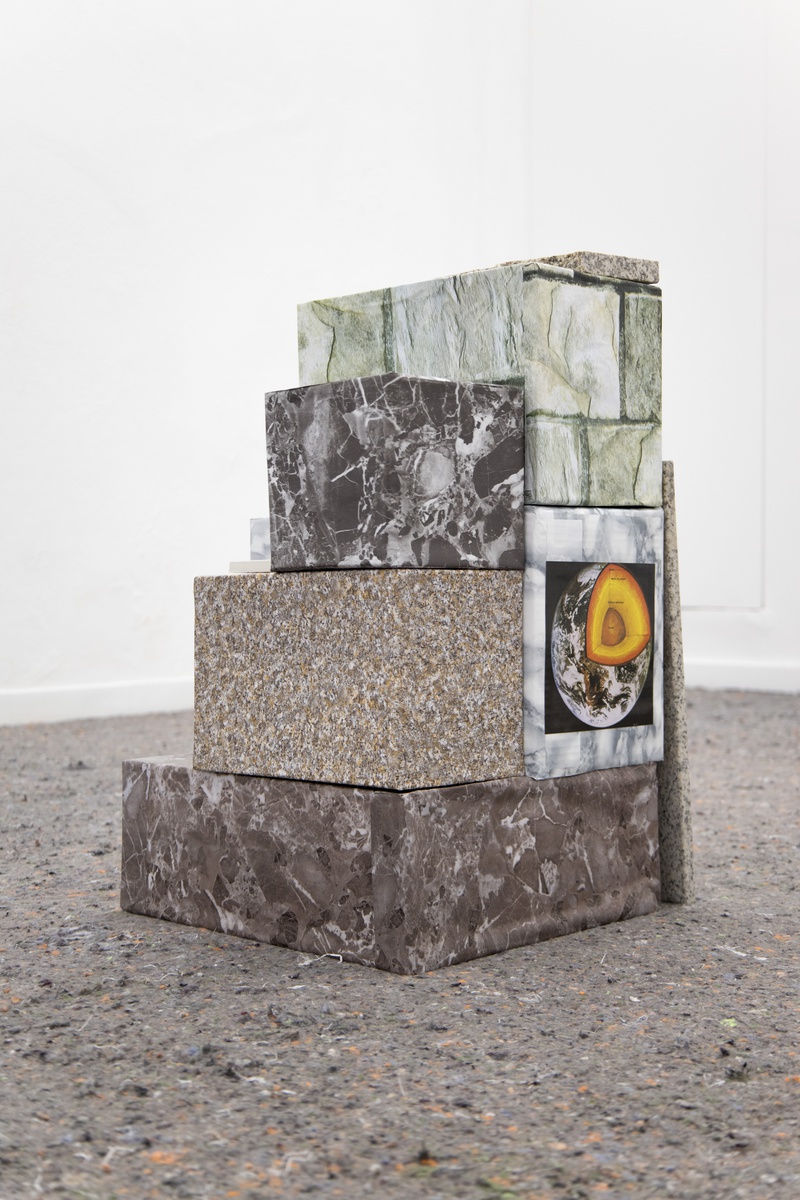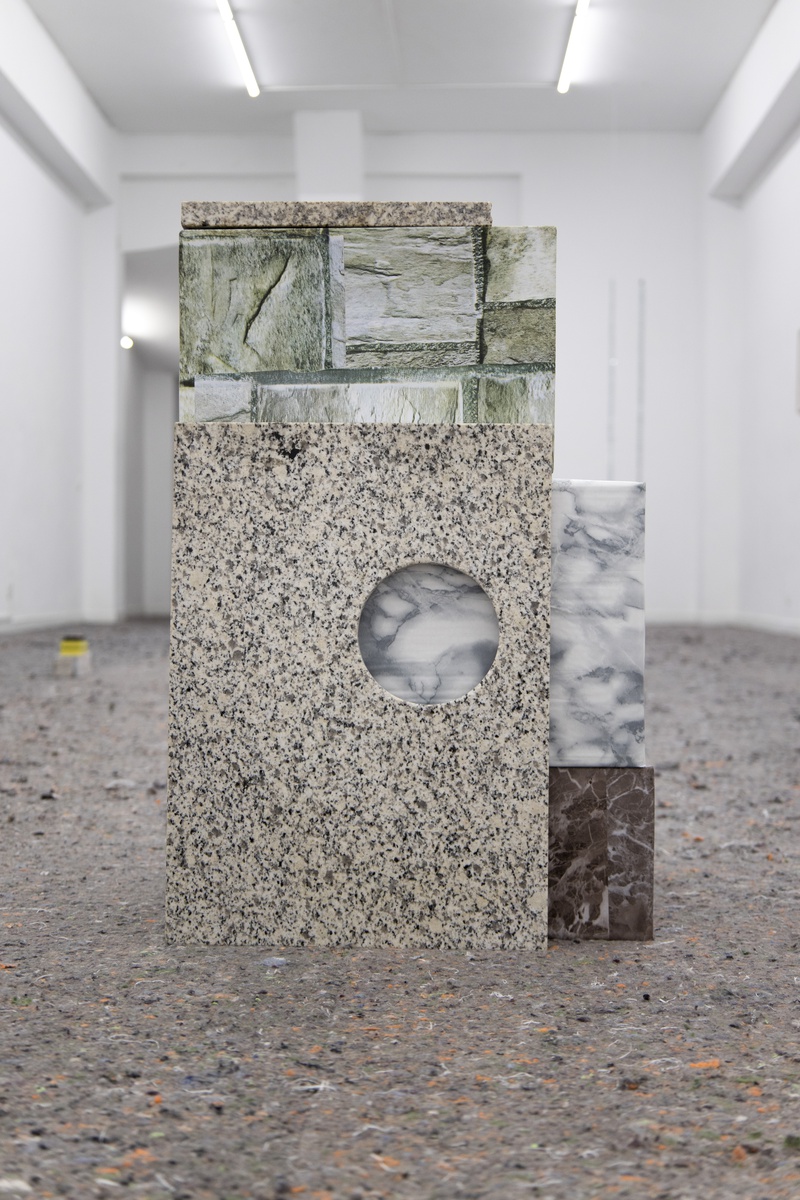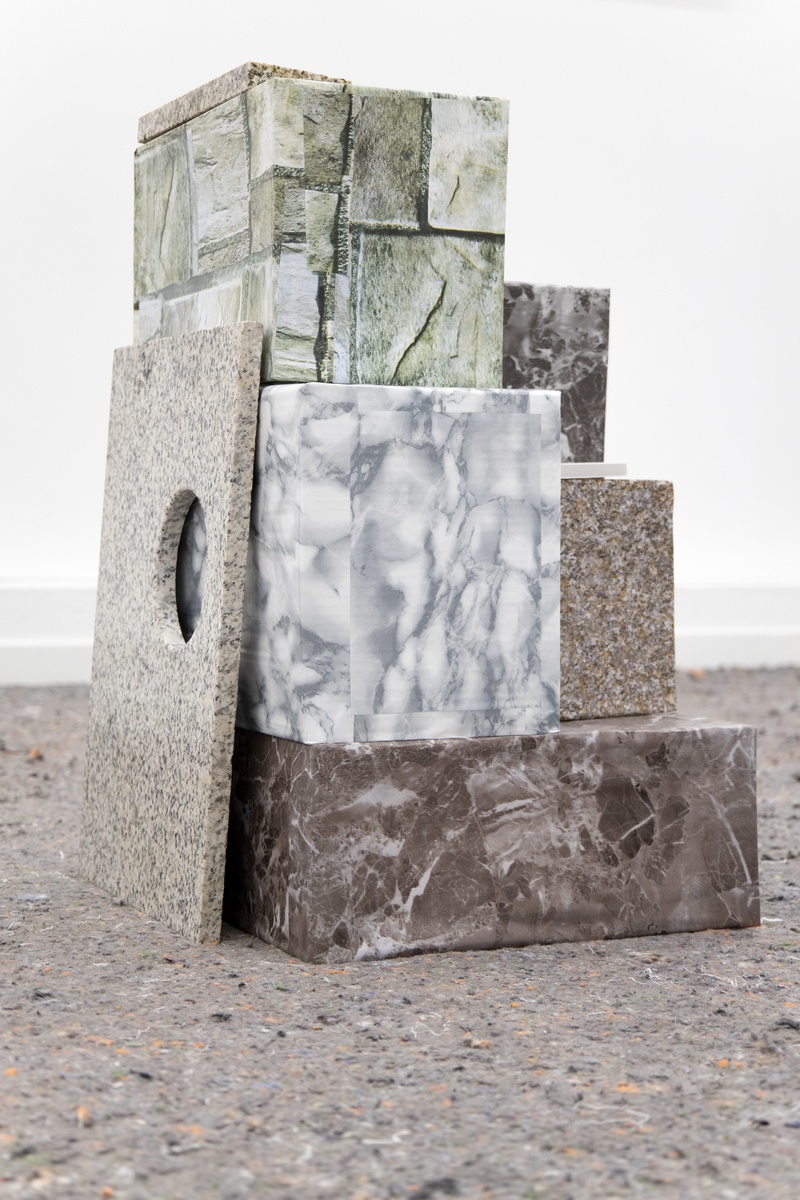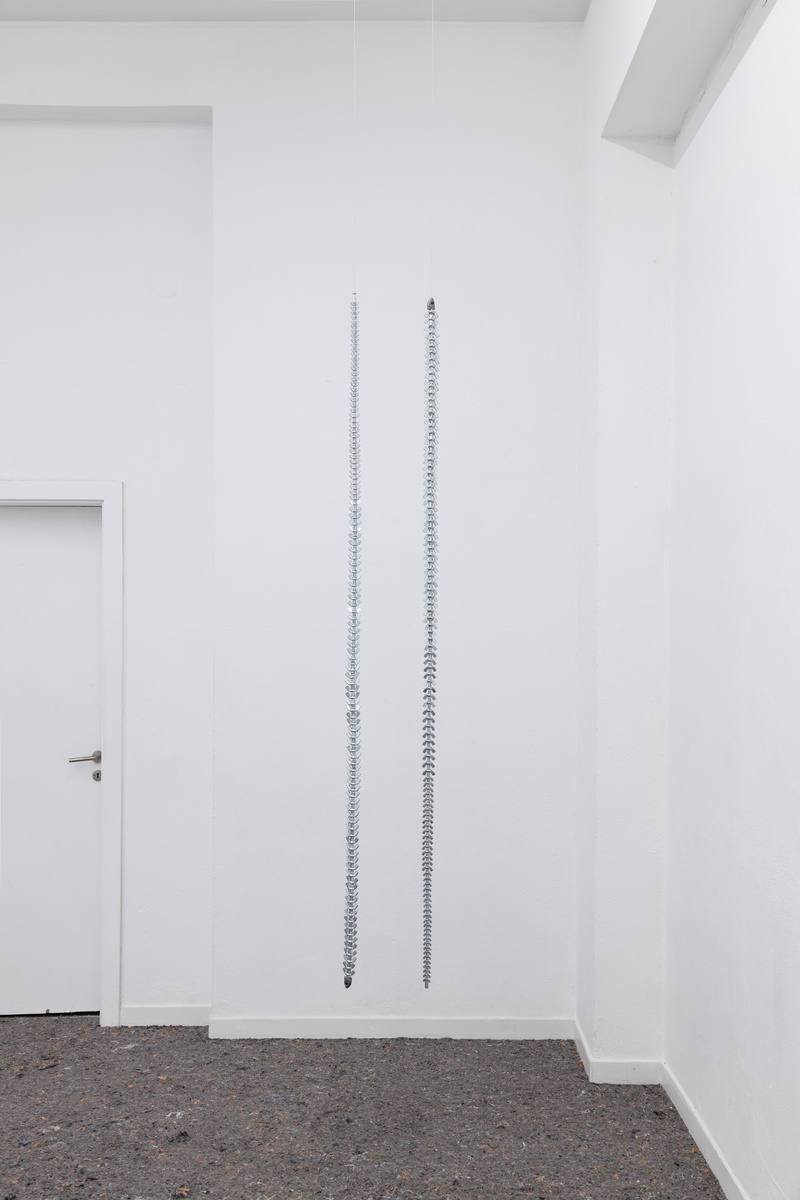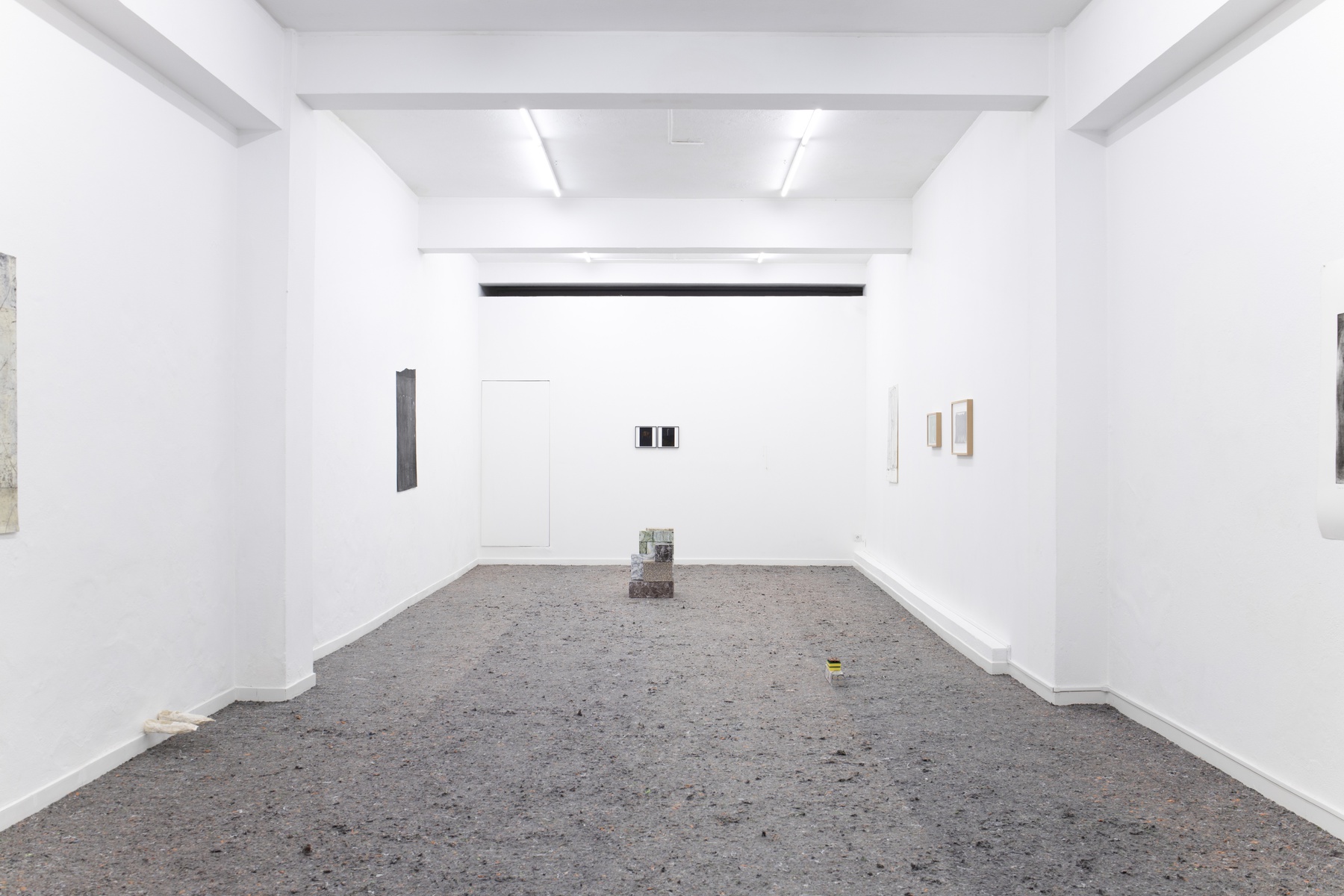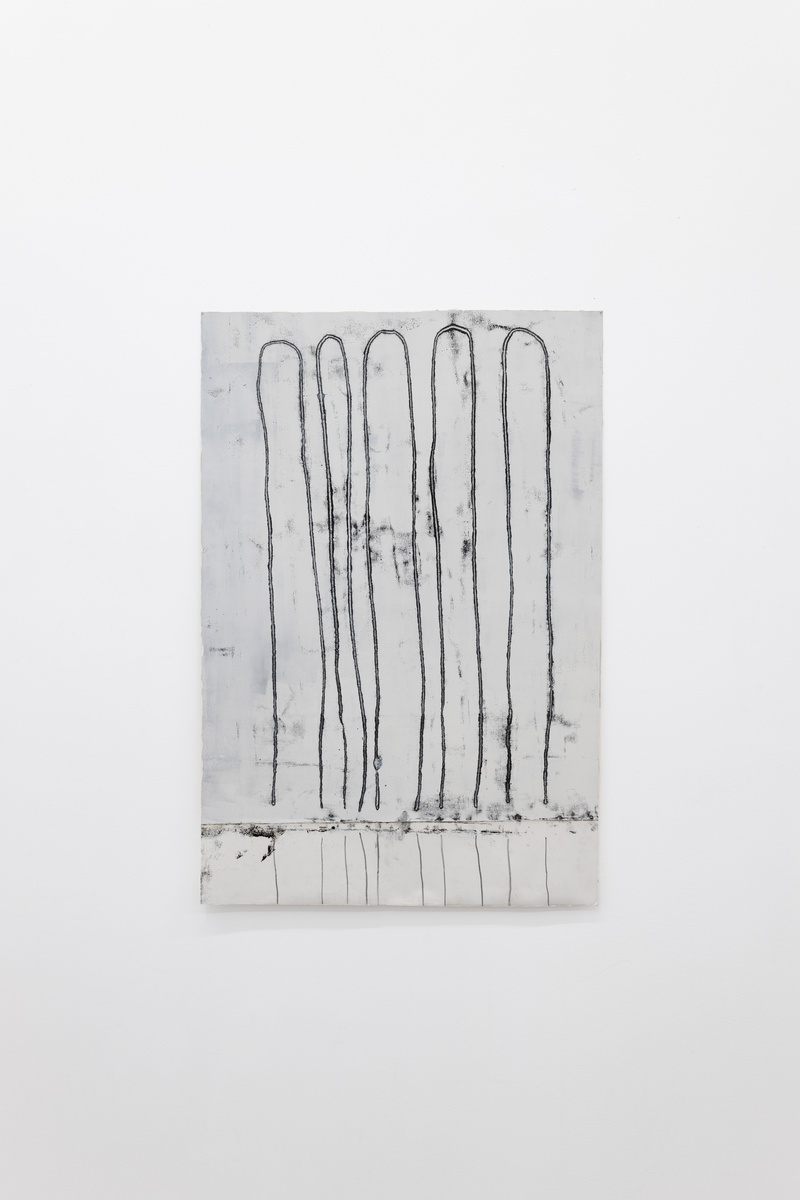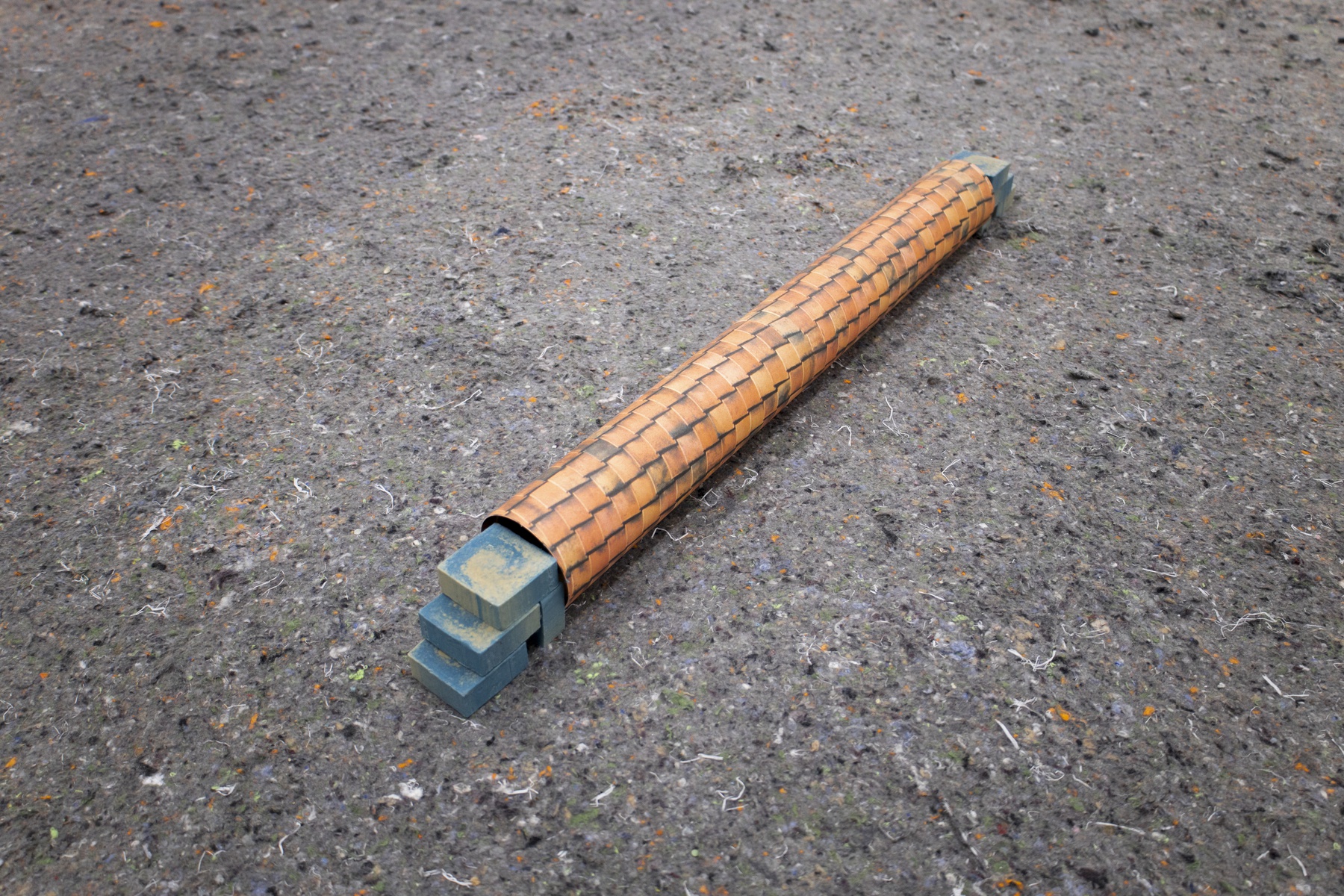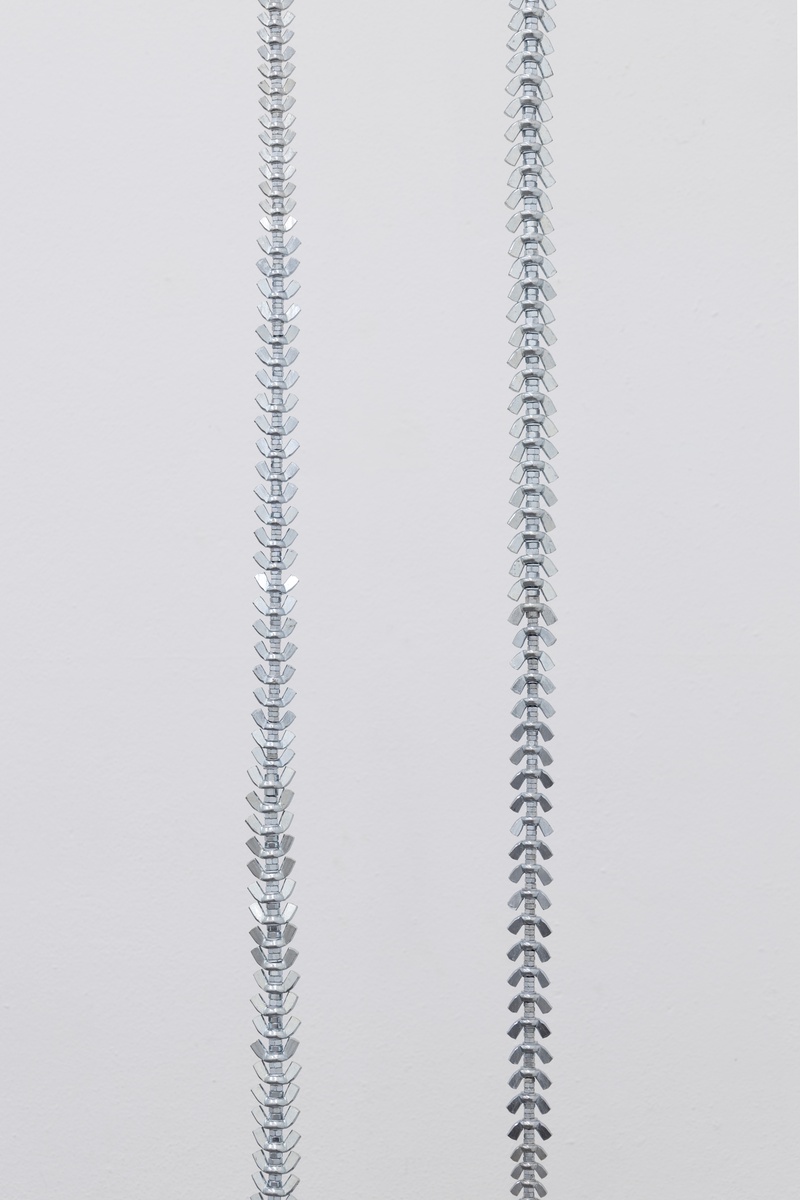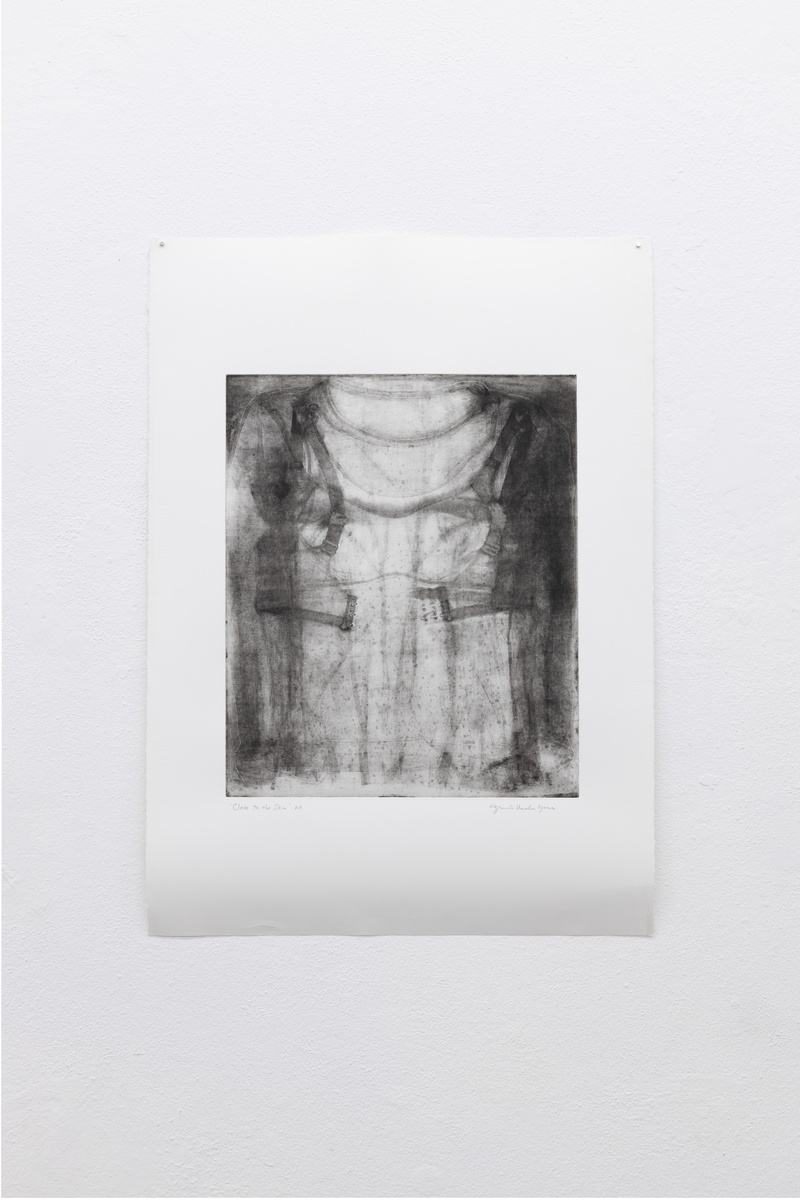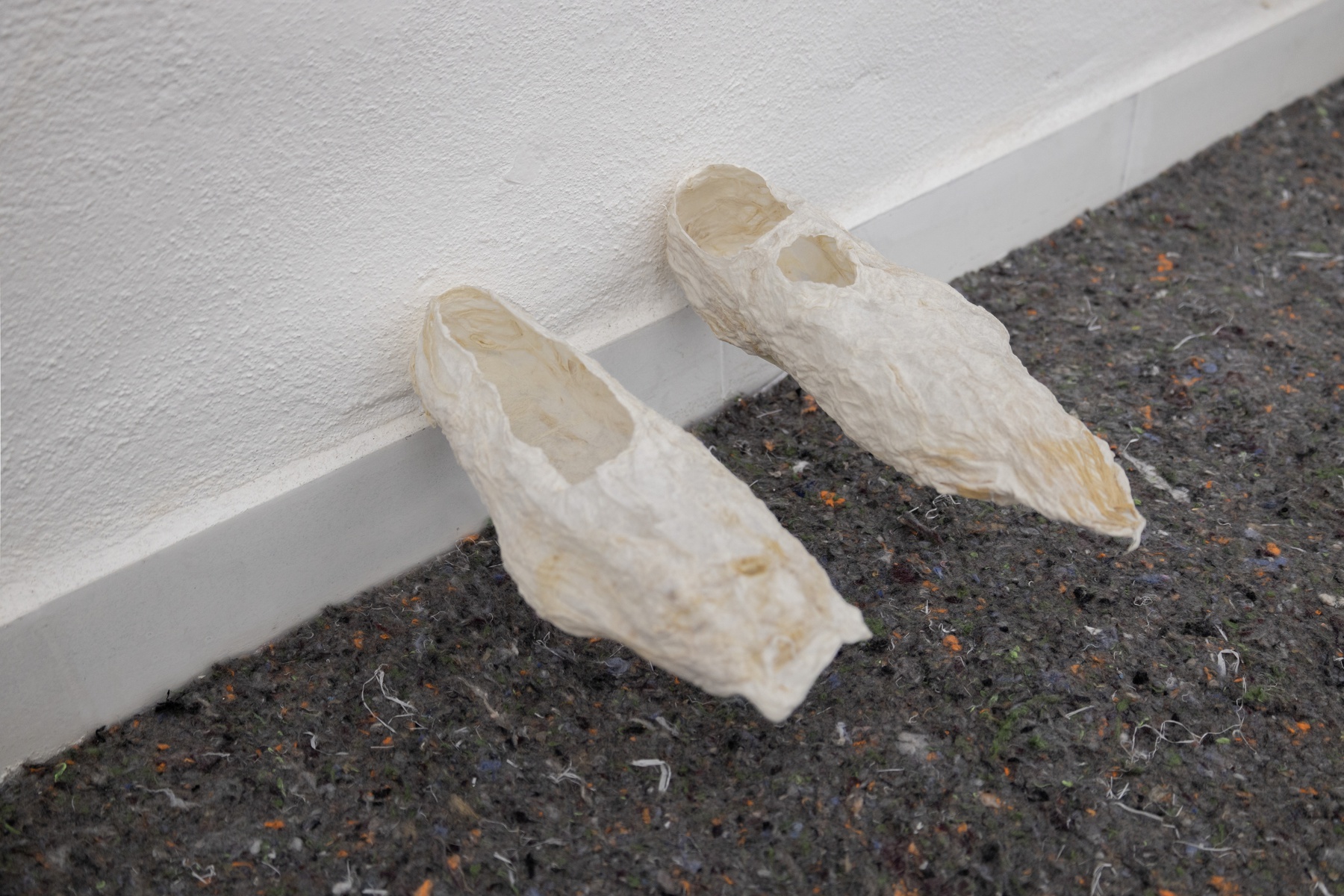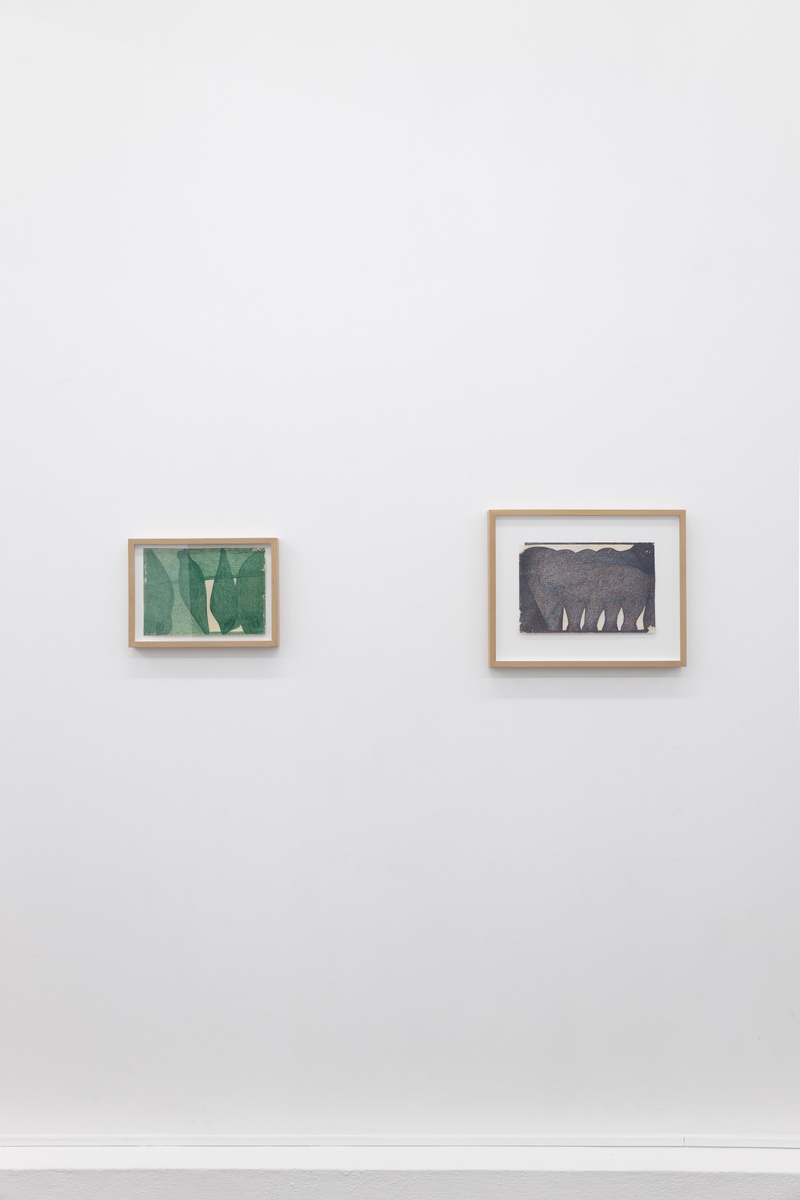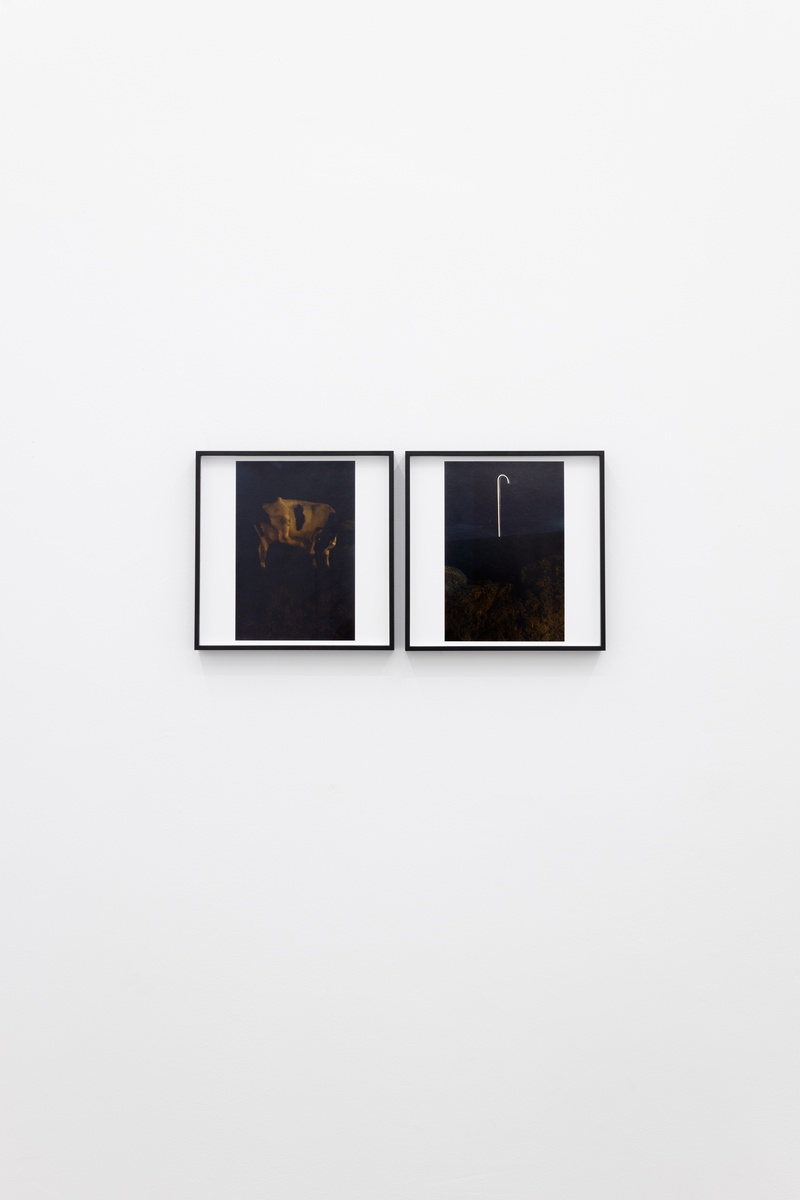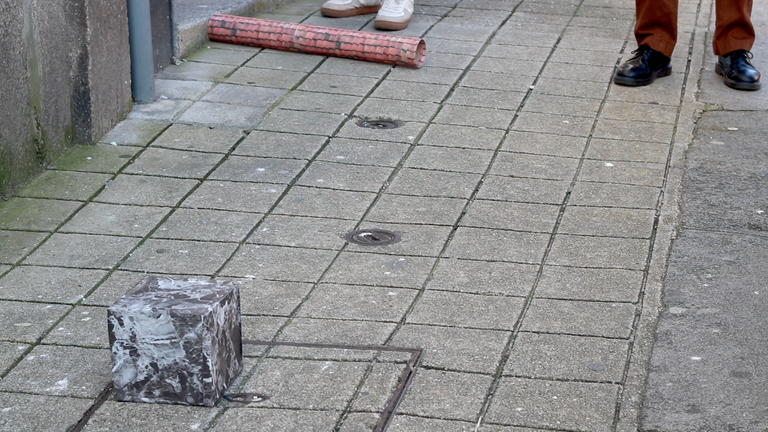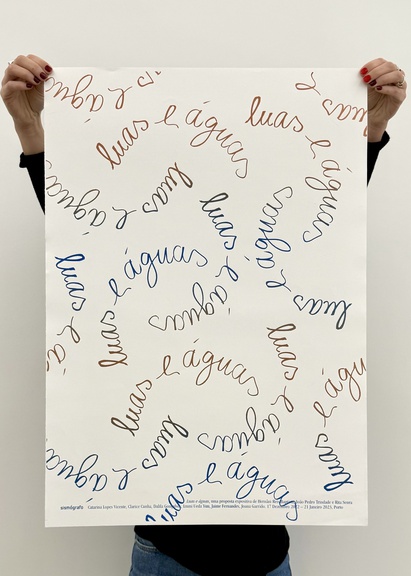Catarina Lopes Vicente,
Clarice Cunha,
Dalila Gonçalves,
Izumi Ueda Yuu,
Jaime Fernandes,
Joana Garrido
Exhibition
17 Dec 2022 – 21 Jan 2023
Catarina Lopes Vicente, Clarice Cunha, Dalila Gonçalves, Izumi Ueda Yuu, Jaime Fernandes, Joana Garrido
"Looking at the sky for guidance is nothing new. There are planets, stars, asteroids, comets, meteoroids, natural satellites. There is what is known and what is unknown; there is light and there is dark; black holes, supernovas, galaxies. There are birds and fish bones; shoes, socks and undergarments; textures, patterns, sponges and blue soap; stones and soil; lines and a cow scratching its head in the twilight. And through these elements, a constellation was drawn that we call Moons and Waters, a project in exhibition format that is materialised in the works of Catarina Lopes Vicente, Clarice Cunha, Dalila Gonçalves, Izumi Ueda Yuu, Jaime Fernandes and Joana Garrido.
In the same way that we don't know the exact reason for the positioning of a star or a moon, the atlas of artists that make up this project results from a succession of more or less improbable events, which led us to continued reflections wherever we went: at the studio, in the streets, in a café, on a trip to Vandoma.
We talked about the unknown, which dwells both above and below. We look at the moon—which is not the same thing as having our head up there—and we imagine the lunar seas on the surface, which are in fact a grey, stony ground, swirling with solidified lava and full of transformations. And down here the waters, an element greater than we are, for we are it too. The dark seawaters are as unknown as the sky, or even more so. And it is from the floor of Sismógrafo that the pieces present themselves; a floor now grey, recycled like the moon, which was once red, as was the centre of the moon.
But the purpose of this selection of works is not to take us to some space or science fiction scenario. No. Quite the contrary, this selection proposes to think about the making in the world, in everyday life and even in death. It is also about complicities, because we are talking about peers.
The work of Izumi Ueda Yuu says so. The Calligrapher's Shoes is, as she herself tells us, dedicated to those who "holds a brush and draws a line". Moulded in Japanese Kozo paper, Izumi was initially attracted to this form when she came across the tradition of shoeing the dead in paper shoes to be cremated. From then on, she sculpted hundreds of shoes, an impulse she can't exactly explain. They are strong and at the same time fragile, charged with a soul force that is also carried to the engraving Close to the Skin, where garments, so linked to our daily life, gain equal intensity.
The works of Catarina Lopes Vicente are made up of gestures, manoeuvres, times and processes. They condense within themselves a vast atlas made of objects and forms anonymous to us, which are subtracted into drawings, lines and blocks of colour. They give space to the enigma, at the same time implying that the relationship with the paper is much greater than what the eye perceives at first instance. They are monotypes, simultaneously flat and three-dimensional, deeply sculptural.
Clarice Cunha's relationship with objects is of another dimension: she gathers them, catalogues them and constructs them. Permeated by a declared intuition and a fascination for textures and materials, she composes sculptures that reflect on human interference in the world. Compositions made of elements that imitate, others original, all reveal the thoughtless consumption of the present and its consequences: in the city streets, forests, beaches, mountains and in those who inhabit them. This is the case of Monumental descartável (Natural gemstones), or the pieces from the project Cinquenta ações para um período de isolamento social, created at a time when the notion of community seemed remote and rewritten.
The Peak of Night is the title of the series that comprises the two photographs that Joana Garrido presents in Moons and waters. Result of one of her many exploratory expeditions, the camera is an extension of her arm and the images come from the reflection and the sensitive eye. Photographed at night, they carry the aura that only dimness provides, bringing to the exhibition the gesture and the body of the more-than-human; a cow caught in the instant in which it was scratching itself, reminds us of the sublime in the most fleeting moments. And the other image, which opens us to interpretation: a line that glimmers behind the rocks; could it be a walking stick?
Dalila Gonçalves invites us to think about the body from the inside. Suspended by a gold thread, hang two teeth. It remind us of childhood when gold ornaments were made from milk teeth. A memory of growth that has been detached from the body but remains close to it. The piece, with the name Post Judgement, is made up of a milk tooth and another wisdom tooth. Like a scale, the one that condenses reason weighs more. It also presents two long fish bodies, skeletons made of butterfly nuts (which, by the nameclature of the parts that compose it, brings to this representation an even greater animal profusion). These long, metallic aquatic animals are suspended from the ceiling, parallel to each other. And the arrangement of the two, one upwards and the other downwards, takes us back to a continuous circle of reformulation and metamorphosis, underlined by the aquatic component, proper to the natural habitat, where one fishes and is fished, in a synchronous action of prey and predator.
And finally we come to the drawings of Jaime Fernandes. He started drawing at the age of 66, four years before his death in 1969. He never exhibited during his lifetime and, as far as is known, he never socialised with artists. His life was permeated by rural work alongside Evangelina, his wife, until he was admitted to the Miguel Bombarda Hospital in Lisbon, where he spent the rest of his life for over three decades. Unexpectedly, the urge to draw arose, making use of the few resources he had to do so: ballpoint pen, marker and paper. But nothing seemed to indicate that the goal was not fulfilled. Animals, human or anthropomorphic figures lived in his imagination. Many birds came out of his hands. Perhaps it was a way of launching the freedom that he did not have, through the enclosure of the panopticon. The watchmen, always present, also appear in his drawings, bringing him to the reality of the ground. "You will die like these portraits", he used to say. And this exhibition presents three drawings where the animal prevails. From the eyes, they could be said to be human, but the strength would be taken away by reducing them to ours.
In this kind of cosmovision, each of these works contributes with distinct perspectives, which at times touch or move apart. A narrative in abyss, made by overlapping, crossed or intersected realities. We find the title of the exhibition in the words of Sophia de Mello Breyner, writing to Teixeira de Pascoaes. The loan made sense to us, because we find in the practice of our peers the admiration that can be seen between these poets. And because the elements will always be greater than us, we see in the making of these people, as Sophia tells us, the same pure emergence: moons and waters." Hernâni Reis Baptista, João Pedro Trindade e Rita Senra
Catarina Lopes Vicente (Lisbon, 1991) lives and works in Cacém, Sintra. She holds a master’s degree in Fine Arts from Escola Superior de Artes e Design (Caldas da Rainha, 2015). In 2018, she won the Calouste Gulbenkian Foundation Visual Arts Grant. She has been showing her work regularly since 2012. For some time now, Catarina has been collecting objects and images that serve as her personal library, and with which her work on paper establishes relationships. https://catarinalopesvicente.weebly.com/
Clarice Cunha (São Paulo, 1985) lives and works in Porto. She holds a master’s degree in fine arts with a specialization in Sculpture from the University of Porto (Porto, 2022) and a degree in Architecture and Urbanism from the Mackenzie University (São Paulo, 2010). Her artistic practice articulates different layers of experience with the reading of the built environment. Through a hybrid plastic language (installations, interventions, sculptures, photographs, collages), Clarice seeks to make her objects reflect on the human presence on Earth and how the intense industrial activity has been altering the nature of this environment. http://www.claricecunha.com.br/
Dalila Gonçalves (Castelo de Paiva, 1982) graduated in Visual Arts-Painting from the Faculty of Fine Arts in Porto (2005) and she obtained a master’s degree in Visual Arts Education (MA) from the Faculties of Fine Arts and Psychology and Educational Sciences of the University of Porto (2009). She finished the first year of the PHD at the same university. In 2008, she was selected for the second edition of the Photography Course of the Gulbenkian Creativity and Artistic Creation Program. From 2010 to 2011, Dalila worked at Ignasi Aballí’s studio in Barcelona while holding a scholarship from the Inov-art program. She was an artist in residence at Inclusartiz (Rio de Janeiro, 2014); at Programme KulturKontakt (Vienna, 2017); at Pivô Art and Research (São Paulo, 2018); and at Fundación Marso (Mexico DF, 2019). In her work, a process of dissection is visible, of discovery of objects, materials, and matters - an unraveling sometimes of their plasticity, sometimes of their history, sometimes of their function, or of everything at the same time. In a practice with a strong processual tendency, she uses video, photography, ceramics, sculpture, and installation. She exhibits regularly in institutions and galleries in the USA, in different countries in Europe, and in South America, where she is represented in public and private collections. https://dalilagoncalves.com/
Izumi Ueda Yuu (Yokohama, 1948) lives in Estoril since 2015. She attended Kuwasawa Design Institute, Tokyo, received BFA in Sculpture from Maryland Institute of Arts of College in Baltimore/USA. Izumi is two-time recipient of both Maryland State Art Counsel Individual Artist Grant and Baltimore City Art Counsel Individual Artist Grant. She was an artist in residence in Foundation Obras Holland & Portugal, Atelier OUTOTSU Printmaking Studio and Awagami Factory/Japan. She was a finalist of the Luxembourg Art Prize 2019. Izumi’s work is about making the connection between art and everyday life. She is interested in the notion of animism that things we use in our daily life can be spirited, respected and loved, creating images and objects with familiar shapes drawn from daily life. https://www.izumiuedayuu.com/
Jaime Fernandes (Covilhã, 1899 - Lisbon, 1969) began drawing when he was over sixty years old and had been hospitalized for over thirty years in Lisbon's Miguel Bombarda Hospital. His drawings are made, mostly with colored ballpoint pens, from a dense mesh of lines, creating a world populated by imaginary animals, human and anthropomorphic figures. Jaime also expressed himself through texts, written in the verses of his drawings or in letters addressed to his wife. The recognition of the artistic value of his work only came after his death. In 1980, seventy-four of Jaime's drawings could be seen in an exhibition at the Calouste Gulbenkian Foundation, the largest dedicated to the author; a year later, around fifty drawings were shown at the S. Paulo Biennial, in the exhibition "Uncommon Art". Since then, his drawings have circulated throughout Portugal, the United States, and Europe and have been included in several publications and exhibitions, in which his work has been recognized as one of the most significant in the history of European art brut. In 2021, the Oliva Art Center presented the exhibition Jaime: "I saw a dog of mine with wolves".
Joana Garrido (Lisbon, 1993) lives and works between Porto and Lisbon. She attended the photography course at Ar.Co, from 2013 to 2018. She works with digital color photography, exploring gloomy environments in the city at night, through buildings, ruins, and nature. She emphasizes the “real” urban settings with remnants of nature wanting to remain; falsely unpopulated, falsely empty. Illuminated by the monochromatic light of streetlamps or by the darkness of night. They are encounters of objects, plants, and damaged structures. Matters transformed by humans. Non-virgin, transitory places. https://cargocollective.com/joanahintzegarrido
Exhibition
17 Dec 2022 – 21 Jan 2023

